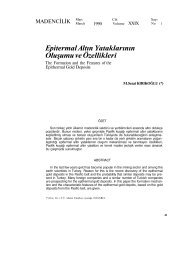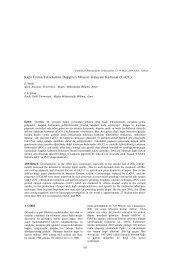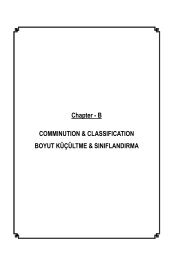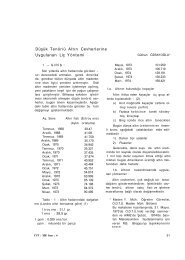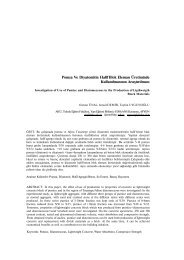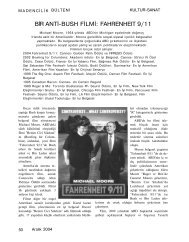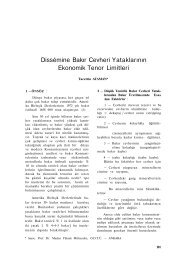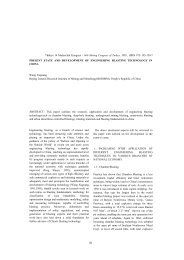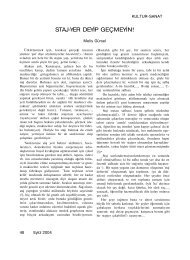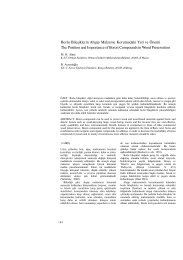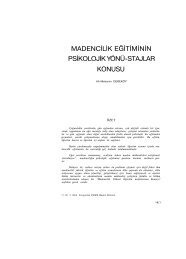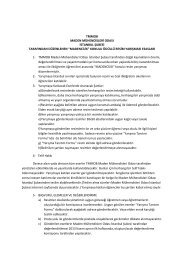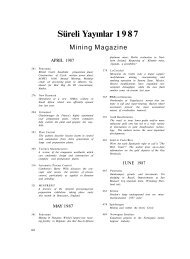A OPEN PIT MINING AÇIK OCAK MADENCİLİĞİ
A OPEN PIT MINING AÇIK OCAK MADENCİLİĞİ
A OPEN PIT MINING AÇIK OCAK MADENCİLİĞİ
Create successful ePaper yourself
Turn your PDF publications into a flip-book with our unique Google optimized e-Paper software.
3.5 SMR classification (Slope Mass<br />
Rating)<br />
The Slope Mass Rating (SMR) was<br />
presented as a new geomechanical<br />
classification for slopes in rock (Romana,<br />
1985). The classification is obtained from<br />
the RMR-system (Bieniawski, 1989), by<br />
using an adjustment factor depending on the<br />
relation between the slope and joints and<br />
also a factor depending on excavation<br />
method (Edelbro, 2003).<br />
SMR = RMR basic + (F 1 . F 2 . F 3 ) + F 4<br />
Where<br />
F1 depends on parallelism between joints<br />
and the strike of the slope face as:<br />
F1 = (1-sin A)2,<br />
Where A is the angle between the strike of<br />
the slope face and strike of the joint.<br />
F2 depends on the joint dip angle in the<br />
planar modes of failure.<br />
F3 refers to the relationship between the<br />
slope face and joint dips (Bieniawski, 1976).<br />
F4 is the adjustment factor depending on<br />
excavation method of the slope.<br />
The results of classification of rock mass<br />
formations of Kef Essenoun is showing in<br />
the following table:<br />
Table 3. Classification of the rock<br />
formations of Kef Essenoun (RMR system)<br />
Properties Quaternary Limestone Phosphate Marl<br />
Compressive<br />
strength<br />
2 7 4 2<br />
Rock quality<br />
designation 13 13 13 13<br />
(RQD)<br />
Spacing of<br />
discontinuities<br />
20 20 20 20<br />
Condition of<br />
discontinuities<br />
10 10 10 10<br />
Ground water<br />
condition<br />
15 15 15 15<br />
RMR basic 60 65 62 60<br />
Table 4. Classification of the rock<br />
formations of Kef Essenoun (SMR system)<br />
Properties Quaternary Limestone Phosphate Marl<br />
F1 0.70 0.70 0.70 0.70<br />
F2 0.15 0.15 0.15 0.15<br />
F3 -25 -25 -25 -25<br />
F4 -8 -8 -8 -8<br />
(F 1 .F 2 .F 3 )+ F 4 -10.62 -10.62 -10.62 -10.62<br />
SMR 49.37 54.37 51.37 49.37<br />
SMR classes<br />
(Romana,<br />
1993)<br />
Description: Class III; Normal<br />
Stability: Partially stable<br />
Failures: Planar failure in some joints and many<br />
wedge failures<br />
Support: Systematic<br />
The results of SMR classification prove<br />
that the mine was partially unstable and that<br />
a plane failure will occur on the level of<br />
some joints from where in this case the<br />
failure occurred on the level of the bedding<br />
plane separating the phosphate layer from<br />
the marl layer.<br />
Common for both soil and rock slopes is<br />
the fact that the failure surface cannot<br />
develop at the same instant throughout the<br />
slope. There must be a progressive<br />
mechanism of failure development<br />
eventually leading to the full collapse of the<br />
slope (Sjöberg, 1996).<br />
3.6 Numerical Simulation<br />
The Modeling is carried out by using the<br />
finite element code for soil and rock<br />
analyses PLAXIS. Calculations are carried<br />
out in plane deformation, by using a model<br />
of 300 m out of 500 m. The Mohr-Coulomb<br />
elastoplastic constitutive law is selected.<br />
This law offers the advantage of a low<br />
number of parameters. The finite- element<br />
model is illustrated in Figure 8.<br />
Figure 8. The model geometry<br />
174



